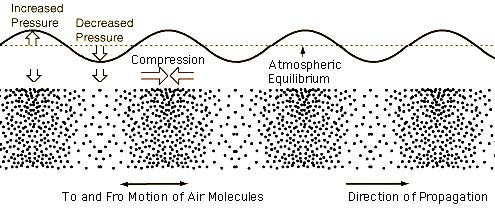The orthodox view of a wave and wave motion is centered around a sine wave or similar configuration. In general this wave model is a measurement of a quantity and/or polarity of energy, sound pressure or sound power (amplitude), viewed over time, as the wave passes a sensing device such as a microphone. Empirical measurements have been made of pressure or power fluctuations over time and a plotting of these measurements creates the typical sine wave form. There doesn't seem to be much said about the nature of that wave itself or the Positive or negative phase. Of which parameters, SVP sees numerous attributes and dynamics. Orthodoxy does recognize that during the Positive or compression phase the media substance does compress or bunch up then in the negative phase the media disperses or rarefies. Orthodoxy erroneously assumes this periodic gathering together and dispersing of the media substance is due to physical forcing of the particles together or them somehow pulling away from each other during the rarefaction phase. In Figure 8.2 - Compression Wave Phase Illustration are shown both models, a sine wave shown above a compression/rarefaction illustrations with matching phases.


See Also
3.8 - There are no Waves
3.9 - Nodes Travel Faster Than Waves or Light
8.3 - Conventional View of Wave Motion
8.4 - Wave types and metaphors
8.5 - Wave Motion Observables
8.6 - Wave Form Components
8.8 - Water Wave Model
9.2 - Wave Velocity Propagation Questions
9.30 - Eighteen Attributes of a Wave
9.31 - Oscillatory Motion creating Waveforms
9.34 - Wave Propagation
9.35 - Wave Flow
Compression Wave
12.05 - Three Main Parts of a Wave
16.06 - Electric Waves are Sound Waves
Compression Wave Velocity
Figure 6.10 - Wave Dynamics between Cube Corners
Figure 6.9 - Russell depicts his waves in two ways
Figure 7.1 - Step 1 - Wave Vortex Crests at Maximum Polarization
Figure 8.1 - Russells Painting of Wave Form Dynamics
Figure 8.10 - Each Phase of a Wave as Discrete Steps
Figure 8.11 - Four Fundamental Phases of a Wave
Figure 8.14 - Some Basic Waveforms and their constituent Aliquot Parts
Figure 8.2 - Compression Wave Phase Illustration
Figure 8.3 - Coiled Spring showing Longitudinal Wave
Figure 8.4 - Transverse Wave
Figure 9.10 - Phases of a Wave as series of Expansions and Contractions
Figure 9.11 - Compression Wave with expanded and contracted Orbits
Figure 9.13 - Wave Flow as function of Periodic Attraction and Dispersion
Figure 9.14 - Wave Flow and Phase as function of Particle Rotation
Figure 9.15 - Wave Flow and Wave Length as function of Particle Oscillatory Rotation
Figure 9.5 - Phases of a Wave as series of Expansions and Contractions
Figure 9.9 - Wave Disturbance from 0 Center to 0 Center
Figure 12.10 - Russells Locked Potential Wave
Figure 12.12 - Russells Multiple Octave Waves as Fibonacci Spirals
Figure 13.13 - Gravity Syntropic and Radiative Entropic Waves
Figure 14.07 - Love Principle: Two sympathetic waves expanding from two points have one coincident centering locus
In the Wave lies the Secret of Creation
Longitudinal Wave
Nodal Waves
Rayleigh Wave
Standing Wave
Standing Waves
Table 12.02.01 - Wavelengths and Frequencies
Three Main Parts of a Wave
Transverse Wave
wave
wave number
WaveLength
